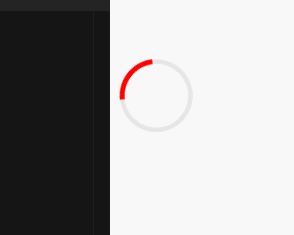这篇文章主要讲解了“即插即用的Vue Loading插件怎么实现”,文中的讲解内容简单清晰,易于学习与理解,下面请大家跟着小编的思路慢慢深入,一起来研究和学习“即插即用的Vue Loading插件怎么实现”吧!
无论最终要实现怎样的网站,Loading状态都是必不可少的一环,给用户一个过渡喘息的机会也给服务器一个递达响应的时间。
从使用方式说起
不管从0开始写起还是直接下载的Loading插件,都会抽象为一个组件,在用到的时候进行加载Loading,或者通过API手动进行show或者hide
<wait></wait>...this.$wait.show()await fetch('http://example.org')this.$wait.hide()或者通过Loading状态进行组件间的切换
<loader v-if="isLoading"></loader><Main v-else></Main>要想注册成全局状态,还需要给axios类的网络请求包添加拦截器,然后设置一个全局Loading状态,每次有网络请求或者根据已经设置好的URL将Loading状态设置为加载,请求完成后在设置为完成。
注册axios拦截器:
let loadingUrls = [ `${apiUrl}/loading/`, `${apiUrl}/index/`, `${apiUrl}/comments/`, ... ] axios.interceptors.request.use((config) => { let url = config.url if (loadingUrls.indexOf('url') !== -1) { store.loading.isLoading = true } }) axios.interceptors.response.use((response) => { let url = response.config.url if (loadingUrls.indexOf('url') !== -1) { store.loading.isLoading = false } })使用时在每个组件下获取出loading状态,然后判断什么时候显示loading,什么时候显示真正的组件。
<template> <div> <loader v-if="isLoading"> </loader> <Main v-else> </Main> </div> </template> <script> ... components: { loader }, computed: { isLoading: this.$store.loading.isLoading }, async getMainContent () { // 实际情况下State仅能通过mutations改变. this.$sotre.loading.isLoading = false await axios.get('...') this.$sotre.loading.isLoading = false }, async getMain () { await getMainContent() } ... </script>在当前页面下只有一个需要Loading的状态时使用良好,但如果在同一个页面下有多个不同的组件都需要Loading,你还需要根据不同组件进行标记,好让已经加载完的组件不重复进入Loading状态...随着业务不断增加,重复进行的Loading判断足以让人烦躁不已...
整理思路
Loading的核心很简单,就是请求服务器时需要显示Loading,请求完了再还原回来,这个思路实现起来并不费力,只不过使用方式上逃不开上面的显式调用的方式。顺着思路来看,能进行Loading设置的地方有,
设置全局拦截,请求开始前设置状态为加载。
设置全局拦截,请求结束后设置状态为完成。
在触发请求的函数中进行拦截,触发前设置为加载,触发后设置为完成。
判断请求后的数据是否为非空,如果非空则设置为完成
最终可以实现的情况上,进行全局拦截设置,然后局部的判断是最容易想到也是最容易实现的方案。给每个触发的函数设置before和after看起来美好,但实现起来简直是灾难,我们并没有before和after这两个函数钩子来告诉我们函数什么时候调用了和调用完了,自己实现吧坑很多,不实现吧又没得用只能去原函数里一个个写上。只判断数据局限性很大,只有一次机会。
既然是即插即用的插件,使用起来就得突出一个简单易用,基本思路上也是使用全局拦截,但局部判断方面与常规略有不同,使用数据绑定(当然也可以再次全局响应拦截),咱们实现起来吧~。
样式
Loading嘛,必须得有一个转圈圈才能叫Loading,样式并不是这个插件的最主要的,这里直接用CSS实现一个容易实现又不显得很糙的:
<template> <div class="loading"> </div></template>...<style scoped>.loading { width: 50px; height: 50px; border: 4px solid rgba(0,0,0,0.1); border-radius: 50%; border-left-color: red; animation: loading 1s infinite linear;}@keyframes loading { 0% { transform: rotate(0deg) } 100% { transform: rotate(360deg) }}</style>固定大小50px的正方形,使用border-radius把它盘得圆润一些,border设置个进度条底座,border-left-color设置为进度条好了。

绑定数据与URL
提供外部使用接口
上面思路中提到,这个插件是用全局拦截与数据绑定制作的:
暴露一个 source 属性,从使用的组件中获取出要绑定的数据。
暴露一个 urls 属性,从使用的组件中获取出要拦截的URL。
<template> ...</template><script>export default { props: { source: { require: true }, urls: { type: Array, default: () => { new Array() } } }, data () { return { isLoading: true } }, watch: { source: function () { if (this.source) { this.isLoading = false } } }}</script><style scoped>....</style>不用关心source是什么类型的数据,我们只需要监控它,每次变化时都将Loading状态设置为完成即可,urls我们稍后再来完善它。
设置请求拦截器
拦截器中需要的操作是将请求时的每个URL压入一个容器内,请求完再把它删掉。
Vue.prototype.__loader_checks = []Vue.prototype.$__loadingHTTP = new Proxy({}, { set: function (target, key, value, receiver) { let oldValue = target[key] if (!oldValue) { Vue.prototype.__loader_checks.forEach((func) => { func(key, value) }) } return Reflect.set(target, key, value, receiver) }})axios.interceptors.request.use(config => { Vue.prototype.$__loadingHTTP[config.url] = config return config})axios.interceptors.response.use(response => { delete Vue.prototype.$__loadingHTTP[response.config.url] return response})将其挂载在Vue实例上,方便我们之后进行调用,当然还可以用Vuex,但此次插件要突出一个依赖少,所以Vuex还是不用啦。
直接挂载在Vue上的数据不能通过computed或者watch来监控数据变化,咱们用Proxy代理拦截set方法,每当有请求URL压入时就做点什么事。Vue.prototype.__loader_checks用来存放哪些实例化出来的组件订阅了请求URL时做加载的事件,这样每次有URL压入时,通过Proxy来分发给订阅过得实例化Loading组件。
订阅URL事件
<template> ...</template><script>export default { props: { source: { require: true }, urls: { type: Array, default: () => { new Array() } } }, data () { return { isLoading: true } }, watch: { source: function () { if (this.source) { this.isLoading = false } } }, mounted: function () { if (this.urls) { this.__loader_checks.push((url, config) => { if (this.urls.indexOf(url) !== -1) { this.isLoading = true } }) } }}</script><style scoped>....</style>每一个都是一个崭新的实例,所以直接在mounted里订阅URL事件即可,只要有传入urls,就对__loader_checks里每一个订阅的对象进行发布,Loader实例接受到发布后会判断这个URL是否与自己注册的对应,对应的话会将自己的状态设置回加载,URL请求后势必会引起数据的更新,这时我们上面监控的source就会起作用将加载状态设置回完成。
使用槽来适配原来的组件
写完上面这些你可能有些疑问,怎么将Loading时不应该显示的部分隐藏呢?答案是使用槽来适配,
<template> <div> <div class="loading" v-if="isLoading" :key="'loading'"> </div> <slot v-else> </slot> </div></template><script>export default { props: { source: { require: true }, urls: { type: Array, default: () => { new Array() } } }, data () { return { isLoading: true } }, watch: { source: function () { if (this.source) { this.isLoading = false } } }, mounted: function () { if (this.urls) { this.__loader_checks.push((url, config) => { if (this.urls.indexOf(url) !== -1) { this.isLoading = true } }) } }}</script><style scoped>....</style>还是通过isLoading判断,如果处于加载那显示转圈圈,否则显示的是父组件里传入的槽,
这里写的要注意,Vue这里有一个奇怪的BUG,
<div class="loading" v-if="isLoading" :key="'loading'"> </div> <slot v-else> </slot>在有<slot>时,如果同级的标签同时出现v-if与CSS选择器且样式是scoped,那用CSS选择器设置的样式将会丢失,<div v-if="isLoading" :key="'loading'">如果没有设置key那.loading的样式会丢失,除了设置key还可以把它变成嵌套的<div v-if="isLoading"> <div></div> </div>。
注册成插件
Vue中的插件有四种注册方式,这里用mixin来混入到每个实例中,方便使用,同时我们也把上面的axios拦截器也注册在这里。
import axiosimport Loader from './loader.vue'export default { install (Vue, options) { Vue.prototype.__loader_checks = [] Vue.prototype.$__loadingHTTP = new Proxy({}, { set: function (target, key, value, receiver) { let oldValue = target[key] if (!oldValue) { Vue.prototype.__loader_checks.forEach((func) => { func(key, value) }) } return Reflect.set(target, key, value, receiver) } }) axios.interceptors.request.use(config => { Vue.prototype.$__loadingHTTP[config.url] = config return config }) axios.interceptors.response.use(response => { delete Vue.prototype.$__loadingHTTP[response.config.url] return response }) Vue.mixin({ beforeCreate () { Vue.component('v-loader', Loader) } }) } }使用
在入口文件中使用插件
import Loader from './plugins/loader/index.js'...Vue.use(Loader)...任意组件中无需导入即可使用
<v-loader :source="msg" :urls="['/']"> <div @click="getRoot">{{ msg }}</div></v-loader>根据绑定的数据和绑定的URL自动进行Loading的显示与隐藏,无需手动设置isLoading是不是该隐藏,也不用调用show与hide在请求的方法里打补丁。
其他
上面的通过绑定数据来判断是否已经响应,如果请求后的数据不会更新,那你也可以直接在axios的response里做拦截进行订阅发布模式的响应。
为什么要使用Vue
Vue是一款友好的、多用途且高性能的JavaScript框架,使用vue可以创建可维护性和可测试性更强的代码库,Vue允许可以将一个网页分割成可复用的组件,每个组件都包含属于自己的HTML、CSS、JavaScript,以用来渲染网页中相应的地方,所以越来越多的前端开发者使用vue。
感谢各位的阅读,以上就是“即插即用的Vue Loading插件怎么实现”的内容了,经过本文的学习后,相信大家对即插即用的Vue Loading插件怎么实现这一问题有了更深刻的体会,具体使用情况还需要大家实践验证。这里是编程网,小编将为大家推送更多相关知识点的文章,欢迎关注!




